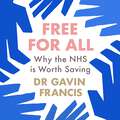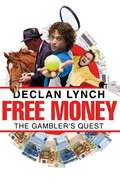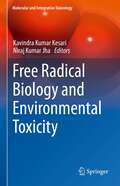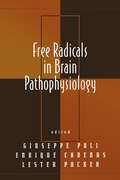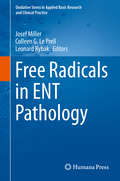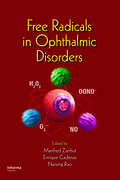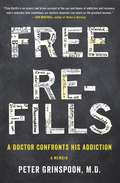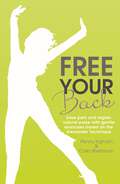- Table View
- List View
Free For All: Why The NHS Is Worth Saving
by Gavin FrancisBritain's health service is dying. Gavin Francis shows us why we should fight for it.Since its birth in 1948, the powers that be have chipped away at the NHS. Now, Britain's best-loved institution is under greater threat than ever, besieged by a deadly combination of underfunding, understaffing and the predatory private sector.In the wake of the pandemic, we have come to accept a 'new normal' of permanent crisis and years-long waiting lists. But, as Gavin Francis reveals in this short, vital book- it doesn't have to be this way, and until recently, it wasn't. Drawing on the history of the NHS as well as his own experience as a GP, he introduces us to the inner workings of an institution that has never been perfect but which transformed the lives and health of millions, for free - and which has never been more important. For those who believe in the future of the NHS and its founding principles, this is essential reading from the bestselling author of Recovery and Intensive Care.
Free Money
by Declan LynchTravel a road rich in possibilities and fraught with danger ...Journalist Declan Lynch's journey begins with a deposit of €100 in an online betting account, kicking off an honest attempt to explore the mysterious allure of gambling. Braving Paddy Power, the Premiership and Belgian women's tennis tournaments on Eurosport, Lynch's darkly humorous diary entries reveal the strange logic behind the punt - and of course there's always the chance of winning a little free money along the way.Drawing on the wise words of sages from Dostoevsky to Corleone to explain, justify and occasionally even excuse his predilection for a punt, Lynch offers a rare glimpse inside the mind of that ever-sanguine individual - the gambler.
Free Radical Biology and Environmental Toxicity (Molecular and Integrative Toxicology)
by Kavindra Kumar Kesari Niraj Kumar JhaThe main aim of this book is to collect a series of research articles and reviews from a diverse group of scientists to share their research work on the role of free radical research and environmental toxicity. This book presents various state-of-the-art chapters of recent progress in the field of cellular toxicology and clinical manifestations of various disorders. Topics include cell signaling, various risk factors, the pathophysiology of disease instigation and distribution, mechanistic insights into metal and nanoparticle toxicity, neural toxicity, nongenotoxic carcinogenicity, immune and idiosyncratic toxicity, prevention, biomarkers related to disease progression and therapeutic strategies. In particular, this book provides valuable insight for researchers, pathologists, and clinicians with an interest in toxicological research and cellular impairments with special emphasis on therapeutic advancement.
Free Radicals in Brain Pathophysiology (Oxidative Stress and Disease)
by Giuseppe PoliThis volume provides an authoritative, comprehensive view of the most current issues in brain pathophysiology and offers a critical evaluation of antioxidant-based therapeutic approaches to neurodegeneration, providing an up-to-date account of the role of antioxidants in the prevention and moderation of clinical symptoms.Examines free radicals
Free Radicals in ENT Pathology
by Colleen G. Le Prell Josef Miller Leonard RybakThis comprehensive volume examines the current state of free radical biology and its impact on otology, laryngology, and head and neck function. The chapters collectively highlight the interrelationship of basic and translational studies in each area, define the challenges to translation, and identify the existing basic issues that demand investigation as well as the opportunities for novel intervention to prevent and treat ENT pathology and impairment. In each chapter, or in some cases pairs of chapters, the author(s) have included or married issues of basic research with translational challenges and research, thus defining the pathway by which new basic insights may lead to interventions to prevent or treat impairment. The final chapter of this book reflects a meeting of all the contributors, culminating in a discussion and "white paper" that identifies the challenges to the field and defines the studies and collaborations that may lead to improved understanding of free radical biology in ENT and, subsequently, new interventions to medically treat ENT pathology.
Free Radicals in Human Health and Disease
by Vibha Rani Umesh Chand Singh YadavThe role of oxidative stress in human disease has become an area of intense interest. Free radicals, a normal product of metabolism, exist in all aerobic cells in balance with biochemical antioxidants. Environmental stress increases the levels of free radicals drastically, thereby disturbing the equilibrium between free radical production and the antioxidant capability causing oxidative stress. Over the years, ROS has been implicated in the pathologies of various diseases like cancer, neurological disorder, cardiovascular diseases rheumatoid arthritis, diabetes etc. This book provides an in depth critical state-of-art reviews from established investigators on free radicals, ROS associated pathogenesis of human diseases, biomarkers of oxidative damage, antioxidants, phytonutrients and other related health concerns of modern society. The present book is aimed at graduate students, researchers in academia, industry and clinicians with the interest in redox biology. Special attention has been devoted to the topic of ROS signalling, oxidative stress induced human pathologies & antioxidative therapies. The book consists of four parts in specified topics based on the current literatures for the better understanding of the readers with respect to their subject-wise interests. The first section of the book provides an overview about the ROS production and their measuring tools and techniques followed by the mechanisms involved in the oxidative stress in the second section. The third section describes the involvement of oxidative stress in different human diseases and the last section focuses on the different strategies to ameliorate oxidative stress induced stress.
Free Radicals in Ophthalmic Disorders
by Narsing A. Rao Manfred Zierhut Enrique CadenasFree radicals are molecules with an unpaired electron in the outer shell or an electron that was damaged from either attack or from a poor splitting bond. After a free radical is formed it will continue to attack other molecules, which usually results in the damage of tissue or destruction of a healthy cell. Free radicals arise normally through met
Free Refills: A Doctor Confronts His Addiction
by Peter GrinspoonFree Refills is the harrowing tale of a Harvard-trained medical doctor run horribly amok through his addiction to prescription medication, and his recovery.Dr. Peter Grinspoon seemed to be a total success: a Harvard-educated M.D. with a thriving practice; married with two great kids and a gorgeous wife; a pillar of his community. But lurking beneath the thin veneer of having it all was an addict fueled on a daily boatload of prescription meds. When the police finally came calling--after a tip from a sharp-eyed pharmacist--Grinspoon's house of cards came tumbling down fast. His professional ego turned out to be an impediment to getting clean as he cycled through recovery to relapse, his reputation, family life, and lifestyle in ruins. What finally moves him to recover and reclaim life--including working with other physicians who themselves are addicts--makes for inspiring reading.
Free Will and the Brain
by Walter GlannonNeuroscientific evidence has educated us in the ways in which the brain mediates our thought and behavior and, therefore, forced us to critically examine how we conceive of free will. This volume, featuring contributions from an international and interdisciplinary group of distinguished researchers and scholars, explores how our increasing knowledge of the brain can elucidate the concept of the will and whether or to what extent it is free. It also examines how brain science can inform our normative judgments of moral and criminal responsibility for our actions. Some chapters point out the different respects in which mental disorders can compromise the will and others show how different forms of neuromodulation can reveal the neural underpinning of the mental capacities associated with the will and can restore or enhance them when they are impaired.
Free Your Back!: Ease Pain and Regain Natural Poise with Gentle Exercise Based on the Alexander Technique.
by Colin Shelbourn Penny InghamIn this practical, easy-to-follow guide Penny shows you how to retrain your body to move, sit and work more easily. The exercises are clearly illustrated by professional cartoonist Colin Shelbourn, one of Penny’s pupils, to help you incorporate them into your everyday life, learning new ways to let your body function without stress.
Free Your Back!: Ease Pain and Regain Natural Poise with Gentle Exercise Based on the Alexander Technique.
by Colin Shelbourn Penny InghamIn this practical, easy-to-follow guide Penny shows you how to retrain your body to move, sit and work more easily. The exercises are clearly illustrated by professional cartoonist Colin Shelbourn, one of Penny’s pupils, to help you incorporate them into your everyday life, learning new ways to let your body function without stress.
Free to Heal: 9 Steps to a Successful, Soul-Satisfying Health Coaching Practice
by Shaunna MenardFree to Heal presents easily implementable simple steps that move health coaches in the direction of their dreams. Many health coaches have a dream to make a greater difference in healing with their own signature soul-satisfying programs, without putting their family at risk. But they have no idea how to do that - until now. Shaunna Menard, MD knows what it looks like to see someone destroy their health before her eyes. In Free to Heal, she shares how she was able to break free and make an even greater difference with her own soul-satisfying health coaching practice. In Free to Heal, health coaches learn how to:Use self-healing principles that clearly and confidently deliver exponential results for their patients and clientsAwaken to what they really want without having to choose between “making a living” and living Break free from a medical career to create their own signature wellness program without putting their family at risk Determine what influencers are sabotaging them and keeping them stuck
Freedom and Justice within Walls: The Bristol Prison experiment (International Behavioural And Social Sciences Ser. #Vol. 18)
by F E EmeryTavistock Press was established as a co-operative venture between the Tavistock Institute and Routledge & Kegan Paul (RKP) in the 1950s to produce a series of major contributions across the social sciences. This volume is part of a 2001 reissue of a selection of those important works which have since gone out of print, or are difficult to locate. Published by Routledge, 112 volumes in total are being brought together under the name The International Behavioural and Social Sciences Library: Classics from the Tavistock Press. Reproduced here in facsimile, this volume was originally published in 1970 and is available individually. The collection is also available in a number of themed mini-sets of between 5 and 13 volumes, or as a complete collection.
Freedom and Neurobiology: Reflections on Free Will, Language, and Political Power
by John R. SearleOur self-conception derives mostly from our own experience. We believe ourselves to be conscious, rational, social, ethical, language-using, political agents who possess free will. Yet we know we exist in a universe that consists of mindless, meaningless, unfree, nonrational, brute physical particles. How can we resolve the conflict between these two visions? In Freedom and Neurobiology, the philosopher John Searle discusses the possibility of free will within the context of contemporary neurobiology. He begins by explaining the relationship between human reality and the more fundamental reality as described by physics and chemistry. Then he proposes a neurobiological resolution to the problem by demonstrating how various conceptions of free will have different consequences for the neurobiology of consciousness. In the second half of the book, Searle applies his theory of social reality to the problem of political power, explaining the role of language in the formation of our political reality. The institutional structures that organize, empower, and regulate our lives-money, property, marriage, government-consist in the assignment and collective acceptance of certain statuses to objects and people. Whether it is the president of the United States, a twenty-dollar bill, or private property, these entities perform functions as determined by their status in our institutional reality. Searle focuses on the political powers that exist within these systems of status functions and the way in which language constitutes them. Searle argues that consciousness and rationality are crucial to our existence and that they are the result of the biological evolution of our species. He addresses the problem of free will within the context of a neurobiological conception of consciousness and rationality, and he addresses the problem of political power within the context of this analysis. A clear and concise contribution to the free-will debate and the study of cognition, Freedom and Neurobiology is essential reading for students and scholars of the philosophy of mind.
Freedom and Neurobiology: Reflections on Free Will, Language, and Political Power (Columbia Themes in Philosophy)
by John SearleOur self-conception derives mostly from our own experience. We believe ourselves to be conscious, rational, social, ethical, language-using, political agents who possess free will. Yet we know we exist in a universe that consists of mindless, meaningless, unfree, nonrational, brute physical particles. How can we resolve the conflict between these two visions?In Freedom and Neurobiology, the philosopher John Searle discusses the possibility of free will within the context of contemporary neurobiology. He begins by explaining the relationship between human reality and the more fundamental reality as described by physics and chemistry. Then he proposes a neurobiological resolution to the problem by demonstrating how various conceptions of free will have different consequences for the neurobiology of consciousness. In the second half of the book, Searle applies his theory of social reality to the problem of political power, explaining the role of language in the formation of our political reality. The institutional structures that organize, empower, and regulate our lives-money, property, marriage, government-consist in the assignment and collective acceptance of certain statuses to objects and people. Whether it is the president of the United States, a twenty-dollar bill, or private property, these entities perform functions as determined by their status in our institutional reality. Searle focuses on the political powers that exist within these systems of status functions and the way in which language constitutes them.Searle argues that consciousness and rationality are crucial to our existence and that they are the result of the biological evolution of our species. He addresses the problem of free will within the context of a neurobiological conception of consciousness and rationality, and he addresses the problem of political power within the context of this analysis. A clear and concise contribution to the free-will debate and the study of cognition, Freedom and Neurobiology is essential reading for students and scholars of the philosophy of mind.
Freedom and the Cage: Modern Architecture and Psychiatry in Central Europe, 1890–1914 (Buildings, Landscapes, and Societies #10)
by Leslie ToppSpurred by ideals of individual liberty that took hold in the Western world in the late nineteenth century, psychiatrists and public officials sought to reinvent asylums as large-scale, totally designed institutions that offered a level of freedom and normality impossible in the outside world. This volume explores the “caged freedom” that this new psychiatric ethos represented by analyzing seven such buildings established in the Austro-Hungarian monarchy between the late 1890s and World War I.In the last two decades of the Habsburg Empire, architects of asylums began to abandon traditional corridor-based plans in favor of looser formations of connected villas, echoing through design the urban- and freedom-oriented impulse of the progressive architecture of the time. Leslie Topp considers the paradoxical position of designs that promoted an illusion of freedom even as they exercised careful social and spatial control over patients. In addition to discussing the physical and social aspects of these institutions, Topp shows how the commissioned buildings were symptomatic of larger cultural changes and of the modern asylum’s straining against its ideological anchorage in a premodern past of “unenlightened” restraint on human liberty.Working at the intersection of the history of architecture and the history of psychiatry, Freedom and the Cage broadens our understanding of the complexity and fluidity of modern architecture’s engagement with the state, with social and medical projects, and with mental health, psychiatry, and psychology.
Freedom and the Cage: Modern Architecture and Psychiatry in Central Europe, 1890–1914 (Buildings, Landscapes, and Societies #10)
by Leslie ToppSpurred by ideals of individual liberty that took hold in the Western world in the late nineteenth century, psychiatrists and public officials sought to reinvent asylums as large-scale, totally designed institutions that offered a level of freedom and normality impossible in the outside world. This volume explores the “caged freedom” that this new psychiatric ethos represented by analyzing seven such buildings established in the Austro-Hungarian monarchy between the late 1890s and World War I.In the last two decades of the Habsburg Empire, architects of asylums began to abandon traditional corridor-based plans in favor of looser formations of connected villas, echoing through design the urban- and freedom-oriented impulse of the progressive architecture of the time. Leslie Topp considers the paradoxical position of designs that promoted an illusion of freedom even as they exercised careful social and spatial control over patients. In addition to discussing the physical and social aspects of these institutions, Topp shows how the commissioned buildings were symptomatic of larger cultural changes and of the modern asylum’s straining against its ideological anchorage in a premodern past of “unenlightened” restraint on human liberty.Working at the intersection of the history of architecture and the history of psychiatry, Freedom and the Cage broadens our understanding of the complexity and fluidity of modern architecture’s engagement with the state, with social and medical projects, and with mental health, psychiatry, and psychology.
Freedom from Constipation: Natural Remedies for Digestive Health
by Christopher VaseyA practical guide to discovering the cause of your constipation and finding the right natural remedy for your unique case • Details the 8 main causes of constipation and how to determine which is at the root of your difficulties • Offers practical advice on how to correct each type of constipation with natural and non-aggressive methods, such as dietary changes, herbs, and relaxation methods • Explains gentle, natural ways to empty the bowels when quick relief is necessary • Reveals how treating constipation properly can restore full function not only to the digestive system but to the liver and kidneys as well Constipation has many causes. Most people do not know the exact cause of their constipation and thus have trouble finding lasting relief. Yet there are many natural remedies available that can be tailored to your body’s specific needs. In this step-by-step guide, Christopher Vasey explains how healthy intestines work and the different forms that constipation can take. He details the 8 main causes of constipation: lack of roughage, lack of water, liver dysfunction, constipating foods or medications, weak muscles, imbalances in intestinal flora, stress and anxiety, and nutritional deficiencies. He helps you discover which of the 8 causes underlies your unique case and offers practical advice on how to correct it with natural and non-aggressive methods, such as dietary changes, herbs, and relaxation techniques. For situations when quick relief is necessary, he provides gentle ways to empty the bowels, including natural laxatives and enemas, explaining which to choose for each type of constipation, but also stressing that these are only temporary solutions. Explaining how constipation can be a symptom of a deeper imbalance, the author explores how treating it properly can restore full function not only to the digestive system but to the liver and kidneys as well. In this practical guide, you will learn how to support the work of your intestines, allowing your body to gradually resume its natural working rhythm.
Freedom from Fred: Living with Friedreich's Ataxia
by Anna Magdalene HandleyOn the night of a debutante ball, events set in motion an emotive and intimate portrayal of the revelation of a life changing condition. Anna Magdalene plunges deep into a personal maelstrom that is both tender and hard-hitting as it explores the hidden recesses of social understanding of her condition, Friedreich's Ataxia. On the quest for healing, Anna embarks on brave and sometimes strange journeys of enlightenment to free herself from the bonds of her condition. In one of these adventures she stumbles on an unexpected answer that brings a true light in the most disarming way, changing her whole view of what freedom is. Simultaneously, she discovers a mutual hope to join life again and a way to live with her condition, 'Fred', while she must. (Blurb by Anna's Carers, Pierre and Lee Figueira)
Freedom to Move: Movement Therapy for Spinal Pain and Injuries
by Josephine KeyFreedom to Move is an evidence informed practical resource which provides movement therapists of all disciplines with an exercise blueprint for rehabilitating spinal pain and many related 'injuries'.In essence, Freedom to Move describes what goes wrong in the spine and what to do about it. It integrates the applicable contemporary neuroscience around spinal movement and pain with the clinical evidence and understanding gained from the author's enquiring practice, and her exploration of various movement approaches and their contribution - or otherwise, to spinal well-being.It examines the relationship between healthy torso structure and functional control and describes and explains the author's model of spinal dysfunction - the remediation of which forms the basis of the author's model of care for the spine, The Key Approach®.The book's main focus is on a practical, therapeutic exercise/movement approach which addresses the common movement faults and dysfunctions observed in people with spinal pain and stiffness.In particular, the Fundamental Patterns of control are introduced as important, innate 'key' movements which naturally provide the sound foundations necessary for a healthy spine - but which have commonly been 'lost' in the movement repertoire of people with spinal pain syndromes.These are re-established and reincorporated into various poses, movements and stretches by way of specifically directed mindful movement explorations. The client is helped to regain more optimal function and move out of pain - with more freedom.The approach is applicable within all industry models of teaching therapeutic movement: in the rehabilitation of spinal pain within physiotherapy, Pilates and Yoga; and in the fitness industry, for injury prevention, health promotion and optimising spinal health in exercise programmes in general.
Freeze Drying of Pharmaceutical Products (Advances in Drying Science and Technology)
by Davide Fissore Roberto Pisano Antonello BarresiFreeze Drying of Pharmaceutical Products provides an overview of the most recent and cutting-edge developments and technologies in the field, focusing on formulation developments and process monitoring and considering new technologies for process development. This book contains case studies from freeze dryer manufacturers and pharmaceutical companies for readers in industry and academia. It was contributed to by lyophilization experts to create a detailed analysis of the subject matter, organically presenting recent advancements in freeze-drying research and technology. It discusses formulation design, process optimization and control, new PAT-monitoring tools, multivariate image analysis, process scale-down and development using small-scale freeze-dryers, use of CFD for equipment design, and development of continuous processes. This book is for industry professionals, including chemical engineers and pharmaceutical scientists.
Freeze-Drying/Lyophilization of Pharmaceutical and Biological Products (Drugs and the Pharmaceutical Sciences)
by Louis Rey Joan C. MayFreeze-drying, or lyophilization, is a well established technology used in the preservation of numerous pharmaceutical and biological products. This highly effective dehydration method involves the removal of water from frozen materials via the direct sublimation of ice. In recent years, this process has met with many changes, as have the regulatio
Freeze-Fracture Studies of Membranes
by Sek Wen HuiThis volume is a kind of celebration of the progress of freeze-fracture electron microscopy in recent years. Many of the authors are leaders of the advancing front. Instead of offering an instruction manual of how to perform new techniques or a review to recover what has happened in the past in respect fields, both which are abundantly available as journal articles and monographs, this volume is a collection of personal testimonies as examples of the power of the new freeze-fracture technology. Since each chapter also centres around specific biological problem, it also serves to illustrate how much the understanding of the problem has been advanced by the new freeze-fracture methodology, which is most cases is developed by the author(s) themselves. A characteristic of frontier development is that many chapters are dealing with controversial subjects. The Inclusion of these subjects in the volume represents the dynamic nature of the subject as viewed by the authors rather than the final verdicts of the subject matter.
Freezing Fertility: Oocyte Cryopreservation and the Gender Politics of Aging (Biopolitics #22)
by Lucy van de WielWelcomed as liberation and dismissed as exploitation, egg freezing (oocyte cryopreservation) has rapidly become one of the most widely-discussed and influential new reproductive technologies of this century. In Freezing Fertility, Lucy van de Wiel takes us inside the world of fertility preservation—with its egg freezing parties, contested age limits, proactive anticipations and equity investments—and shows how the popularization of egg freezing has profound consequences for the way in which female fertility and reproductive aging are understood, commercialized and politicized.Beyond an individual reproductive choice for people who may want to have children later in life, Freezing Fertility explores how the rise of egg freezing also reveals broader cultural, political and economic negotiations about reproductive politics, gender inequities, age normativities and the financialization of healthcare. Van de Wiel investigates these issues by analyzing a wide range of sources—varying from sparkly online platforms to heart-breaking court cases and intimate autobiographical accounts—that are emblematic of each stage of the egg freezing procedure. By following the egg’s journey, Freezing Fertility examines how contemporary egg freezing practices both reflect broader social, regulatory and economic power asymmetries and repoliticize fertility and aging in ways that affect the public at large. In doing so, the book explores how the possibility of egg freezing shifts our relation to the beginning and end of life.
Freiheitseinschränkende Maßnahmen bei Menschen mit Demenz in professionellen Sorgebeziehungen: Kritische Darstellung und ethisch-fachliche Reflexion
by Sebastian RitziDieses Open-Access-Buch befasst sich kritisch mit der Anwendung freiheitseinschränkender Maßnahmen (FeM) bei Menschen mit Demenz in professionellen Sorgebeziehungen, die sowohl im Hinblick auf ihren vermeintlichen Nutzen als auch auf ihre ethische Tragweite zu hinterfragen sind. In einer disziplinübergreifenden Analyse des Phänomens von FeM bei Menschen mit Demenz werden Diskurse und Erkenntnisse aus Pflegewissenschaft, Gerontologie, Rechtswissenschaft und Ethik gebündelt, zueinander in Beziehung gesetzt und erweitert. Die empirisch informierte Gesamtdarstellung wird dabei ergänzt durch eine tiefgreifende Reflexion der Personalität, Vulnerabilität und Leiblichkeit von Menschen mit Demenz. Davon ausgehend werden konkrete Kategorien und konzeptionelle Zugänge zur Bewertung und Einzelfallprüfung von FeM in professionellen Sorgebeziehungen entwickelt.
